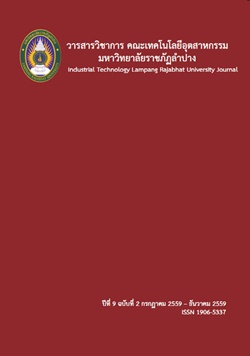11. การพัฒนาสูตรเนื้อดินเพื่อใช้ผลิตเชิงชายสำหรับตกแต่งอาคาร
Keywords:
การพัฒนาสูตรเนื้อดิน, การผลิต, เชิงชายสำหรับตกแต่งอาคาร, Clay Body Formulation, Production, Perforated EavesAbstract
การวิจัยครั้งนี้มีวัตถุประสงค์ 1) เพื่อทดลองหาสูตรส่วนผสมและสมบัติทางกายภาพของเนื้อดินโดยใช้ดินเหนียวท้องถิ่นที่มีความเหมาะสมในการผลิตเชิงชายเซรามิกสำหรับตกแต่งอาคาร 2) เพื่อทดลองผลิตเชิงชายเซรามิกสำหรับตกแต่งอาคาร 3) เพื่อประเมินความพึงพอใจของผู้บริโภคที่มีต่อผลิตภัณฑ์เชิงชายเซรามิก โดยทดลองสูตรส่วนผสมจากวัตถุดิบ 3 ชนิด คือ ดินเหนียวทะเลแก้ว เถ้าแกลบ และดินขาวลำปาง จำนวน 36 ตัวอย่าง ทำการขึ้นรูปชิ้นงานด้วยวิธีการอัดแบบพิมพ์ แล้วนำไปเผาทดลองที่อุณหภูมิ 1200 องศาเซลเซียส บรรยากาศออกซิเดชัน ทดสอบสมบัติทางกายภาพของเนื้อดินก่อนเผาและหลังเผา ได้แก่ ความสามารถในการขึ้นรูปด้วยการอัดแบบพิมพ์ ความหดตัว ความดูดซึมน้ำ และสีของเนื้อดิน ผลการวิจัยพบว่าดินเหนียวทะเลแก้ว สามารถใช้เป็นส่วนผสมของเนื้อดินสำหรับผลิตเชิงชายเซรามิกตกแต่งอาคารทดแทนการใช้ไม้ธรรมชาติได้ ส่วนผสมที่เหมาะสมได้แก่ สูตรที่ 3 ในส่วนผสมประกอบด้วย ดินเหนียวทะเลแก้วร้อยละ 70 เถ้าแกลบร้อยละ 10 และดินขาวลำปาง ร้อยละ 20 เนื้อดินขึ้นรูปด้วยการอัดแบบพิมพ์ได้ดี ความหดตัวก่อนเผาเฉลี่ยร้อยละ 4.11 ความหดตัวหลังเผาเฉลี่ยร้อยละ 11.69 ความดูดซึมน้ำเฉลี่ยร้อยละ 4.66 เนื้อดินมีสีน้ำตาลเข้ม ผู้วิจัยนำผลิตภัณฑ์ไปประเมินความพึงพอใจโดยประชาชนที่เข้ามาซื้อสินค้าในร้านจำหน่ายวัสดุตกแต่งบ้าน และร้านจำหน่ายผลิตภัณฑ์ไม้สำหรับสร้างบ้านจำนวน 50 คน พบว่า ผลิตภัณฑ์มีความเหมาะสมสามารถนำมาทดแทนเชิงชายไม้ธรรมชาติได้ มีค่าเฉลี่ย 3.80 ในระดับ มาก รูปแบบผลิตภัณฑ์มีความสวยงามเหมาะสม มีค่าเฉลี่ย 4.50 ในระดับ มากที่สุด วัสดุที่นำมาใช้ผลิตมีความเหมาะสม มีค่าเฉลี่ย 4.30 ในระดับ มาก ความเหมาะสมกับการนำไปใช้งาน มีค่าเฉลี่ย 4.10 ในระดับ มาก และราคาของผลิตภัณฑ์มีความเหมาะสม มีค่าเฉลี่ย 3.10 ในระดับ ปานกลาง ความพึงพอใจโดยรวม ค่าเฉลี่ย 3.96 อยู่ในระดับ มาก
Clay Formulas Used in the Production of Perforated Eaves
The objectives of this research were: 1) to find the composition and physical properties of local clay suitable for the production of ceramic eaves; 2) to produce prototype eaves; and 3) to assess the level of customer satisfaction with the eaves. 36 samples of a mixture of Talay Kaew clay, husk ash and China clay were pressed in molds and fired at 1,200°C under an oxidation atmosphere. The physical properties of the clay were examined before and after firing to find its compressive forming ability, shrinkage, water absorption, and color. The results showed that the formula comprised of Talay Kaew clay, husk ash and China clay at a ratio of 70:10:20 was suitable as a substitute for wood for use in producing ceramic perforated eaves. The mixture was suitable for forming in a mold, the dry shrinkage before firing was 4.11% before and 11.69% after firing, the average water absorption was 4.66%, and the fired color was dark brown. Customer satisfaction was evaluated from 50 customers who purchased products from home furnishing and building stores. The findings showed that: the quality of clay perforated eaves as a substitute for wood was assessed at a high level of 3.80; the aesthetic quality of the product was assessed at the highest level (4.50); the appropriateness of the material was assessed at a high level (4.30); the product usability was assessed at a high level (4.10); the price of the product was assessed at a moderate level (3.10); and the overall satisfaction was at the high level of 3.96.






